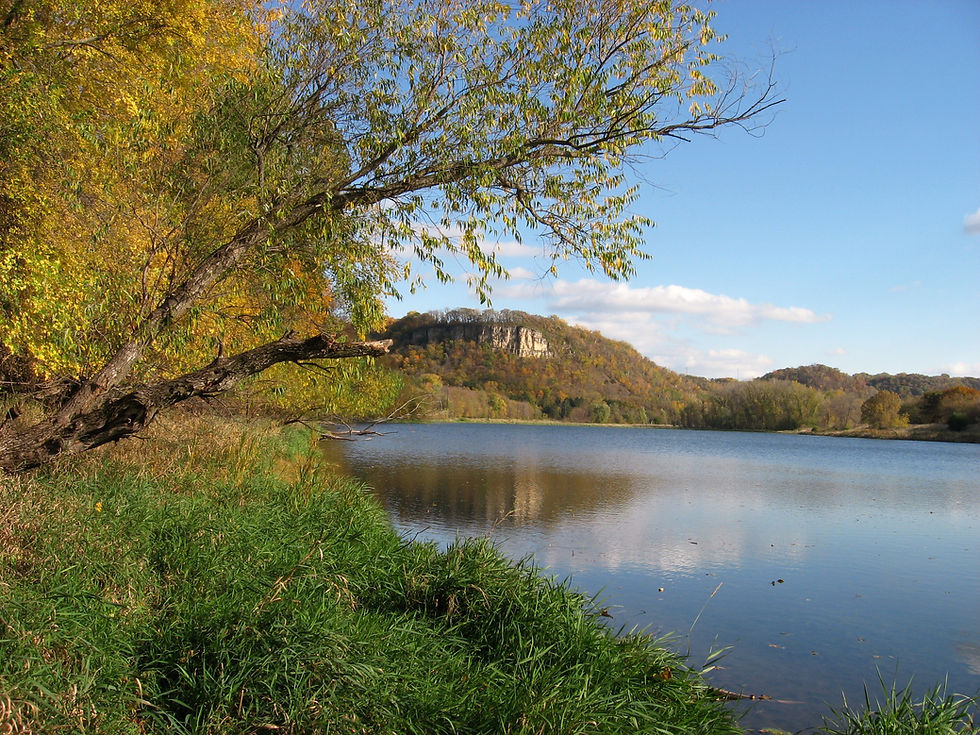Bird Surprises and Highlights
- Bruce Ause
- Jun 8, 2018
- 3 min read

Peregrine Falcon Photo Credit: Dudrey Smith
With the widespread use of pesticides in the 1950's and 1960's, the peregrine falcon became an endangered species over much of it's range including the steep limestone bluffs in our area. Following the restriction on the use of DDT in 1972, peregrine falcons have made a remarkable recovery. Jackie Fallon from the Midwest Peregrine Society and the late Bud Tordoff, Director of the Bell Museum at the University of Minnesota, began looking for peregrine activity on Wacouta's Rattlesnake Bluff in the mid-1990's.
It wasn't until the spring of 2005 that they observed falcons on the bluff. The spring of 2010 saw the first and only successful nesting of peregrines with two white eyasses banded and eventually fledged. There have been a few unsuccessful nesting attempts since 2010. These nesting failures are usually the result of bad weather or predation by great horned owls or bald eagles.

Rappelling
With frequent sightings of two adult falcons on the bluff the past several weeks, expectations were running high that 2018 might yield nesting success. On the afternoon of Tuesday May 22nd, staff from the Midwest Peregrine Society rappelled down to the nest site hoping to confirm those expectations. Unfortunately no young falcons were found.

Western Male Tanager Photo Credit: Tim Schmitz
On Wednesday May 9th, I received a report from Welch resident Tim Schmitz of the sighting of a rare male western tanager frequenting his bird feeding station the past few days. These birds are quite common in the coniferous forests along the west coast and are rarely observed east of the rocky mountains. Western tanagers are primarily insect eaters, but will eat berries and fruits when insects are in short supply. Interestingly enough, this tanager was visiting Tim's grape jelly feeder. Birds this far out of their range are usually blown off course by a severe windstorm during migration.

Cattle Egret
On Thursday May 10th, I received a report from former Wacouta resident Mary Nappen of her sighting of a cattle egret in the field on the east side of Wacouta road. This species of egret is considerably smaller than the great egret commonly observed in our area. Cattle egrets are typically observed in the southeastern states and frequently forage in livestock pastures.

Backyard Pond and Nesting Boxes
Kathy and I have had a small pond in our backyard for many years. The pond is supplied with water from snow melt, rain and water off the roof of the south side of our house via a drain tile. Initially, our two nesting boxes were nailed in a cottonwood and spruce tree. Our only success in attracting wildlife was limited to raccoons, gray and red squirrels. It wasn't until we mounted the boxes on top of slippery metal pipes that we started attracting wood ducks. Even with this small pond, we have had as many as ten wood ducks here at one time.

Hen Wood Duck
Once the hen wood duck has selected this nesting box for her new brood of ducklings, she will lay one egg per day until the clutch is complete. This can very from 8 to 14 eggs. At this point she will begin her 28 to 32 day incubation period. All eggs will hatch within a couple hours and the new ducklings stay in the box overnight. The next morning the hen will stick her head out of the box two or three times checking for danger.

Jumping Duckling
Once the hen is satisfied the coast is clear, she will quickly exit the box and drop straight to the ground. On her way down, she is calling for her ducklings to follow. Keep in mind, this new generation is not capable of flying. Because of their hollow bones and abundance of down feathers, they seldom get injured. In less than 30 seconds all ducklings will be on the ground. They appear to come out of the box like popcorn.

Hen Wood Duck with Brood of Ducklings
After the last duckling reaches the ground, the hen gathers her brood and takes them into the pond. It is amazing that these new ducklings immediately and instinctively begin feeding on insects on the surface of the waters. After giving the ducklings a while to become acclimated to their new environment, it is time to head for the river.

Journey to the River
The hen will immediately gather up her brood and begin her tortuous 200 yard journey to the river hoping to avoid predators, dogs, cats and traffic. Once in the water, the odds for survival of the ducklings will improve. Even at that, only a couple of these young ducks will be alive at this time next year.




Comments